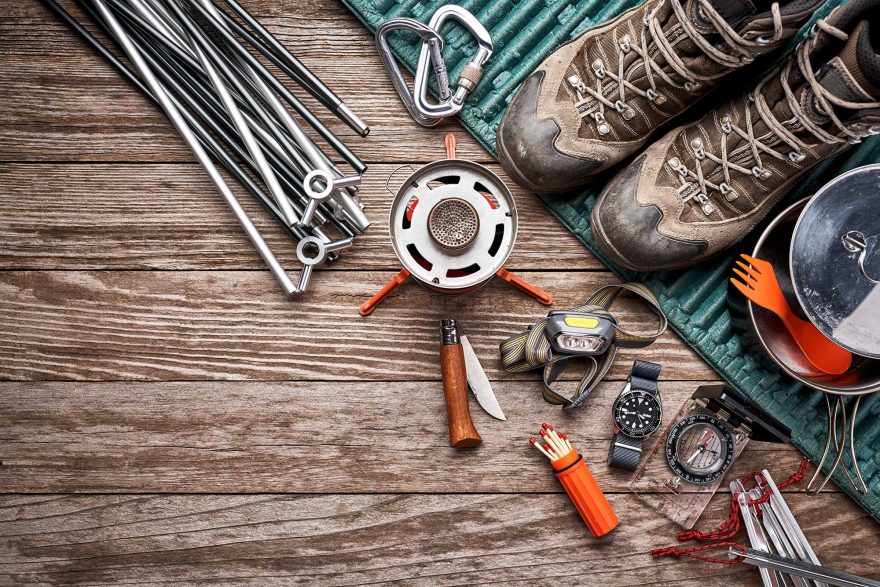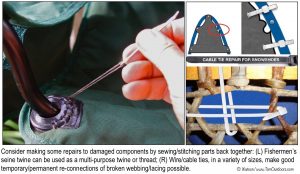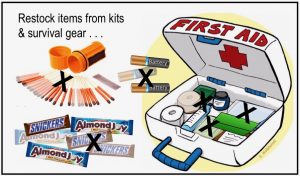
Image by Brian Goodman, Shutterstock
Much of our outdoor gear — whether it’s for hunting, fishing, paddling or simply casual hiking — suffers from the the wear/tear or consumption of use throughout the summer season. Make time during the “off season” to repair or replace gear that became worn, damaged or otherwise utilized this year so you are ready to go again when you venture out next spring (or transition into other winter activities that rely up-on many of the same components).
Restoring gear includes tasks such as bringing back the edge to a dulled knife or simply smoothing out the pull of a zipper on a sleeping bag. It might also mean cleaning out or adjusting clogged or obstructed valves on your gas-fueled camp stoves. It’s always good to try to repair damaged gear ASAP — either as a quick fix in the field before even more damage is done, or later when you can make more lasting repairs with the proper agents and procedures.
Who hasn’t sneaked a hunger-relieving bite into one of those candy bars in your survival kit? After a summer of “emergency” nibbling, you will probably need to replenish your stash of sweets. How many Band-Aids did you use or dispense from your first-aid kit? What about those times you forgot your lighter or even your flint/steel and grabbed an all-weather match from your “ditch kit” to start your campfire? The list goes on and on, innocent pilfering that slowly depletes vital pieces of gear throughout the season — often forgotten until you need them most and realize they’re gone.
Making it a habit to check your outdoor equipment also reminds you to inspect its condition for deterioration, spoilage and items simply too old/worn to be any good anymore. Here are some key maintenance/repair-replace protocols (in the field and at home) to help you know the readiness of your gear and supplies. [NOTE: In all cases, check with manufacturer before using any adhesives that might compromise fabrics, coatings or sealants.]

Tents
- Always keeping tent clean is preventative maintenance; check tent and fly for separation of waterproof coating; check for breaks, kinks in poles; separated seams, rips and thin spots;
- Check lines for fraying, cracks in clips and connectors.
Sleeping Gear
- Soiled insulation reduces its efficiency, build loft back up with a good cleaning at sea-son’s end; [Check manufacturer’s cleaning recommendations].
- Repair and holes or seam separations as needed; check ease of zipper pulls;
- Check for leaks in inflatable pads (inflate, submerge and look for bubbles, mark), patch to fix.

Illustration by Tom Watson
Camp Appliances
- Check fuel lines for potential obstructions, burners for soot build-up; use white gas on rag to wipe/scrub areas where residue can build up;
- Carefully remove pin insert in fuel jet and clean; check all, seals, valves and other components.
Emergency Food Supplies
- Check inventory of high-energy “emergency” food you may have taken from your kit;
- Check for packaged food items that have deteriorated due to age, moisture, etc.;
- Replenish any spices or herbs that are spent or past their prime.

Illustration by Tom Watson
First Aid Kit
- Refresh/replace inventory of small bandages as needed;
- Check seals and condition of ointments, lotions, liquids (iodine, etc.);
- Check quality of tablets and capsules (crumbly, deformed, signs of moisture);
- Check expired medications or changes in dosages, etc.;
- Inspect packets of sterilized bandages, pads, etc. with broken seals should be replaced;
- Check kit itself for worn, weak seals or loss of waterproofing.
Hunt/Fish Gear
- Thoroughly clean firearms, double check they are unloaded before storing;
- Clean and lube fishing reels; clean ferrules on two-piece rods;
- Clean lures, sharpen or replace hooks; dry out tackle box before storage;
- Replace spent or worn line on reel.

Illustration by Tom Watson
Paddle Gear
- Rinse and clean all paddling gear and boat assemblies (critical for salt-water use);
- Replace frayed deck lines, compromised hatch covers/latches, etc.
- Consider re-enforcing paddle tips, keel with abrasion strips;
- Check for wear/tear on life jackets;
- Smooth out abrasions on rotomold hulls, check for breaches in hull; [CRITICAL: check with manufacturer before applying heat, using adhesives or cleaners on hull material].
Clothing
- Fix the rips, lost buttons, stressed seams, stuck zippers;
- Check waterproofing on footwear; rain gear, etc.
Like most situations we encounter outdoors or anywhere, prevention is so much better than trying to find — and execute — the proper cure. When we do have to deal with the “cure,” it’s better to attend to a temporary fix before it becomes a major breakdown. Getting a head start on your next season of adventuring is a good investment on your future enjoyment of the outdoors.
Be safe; Be smart; Have fun out there!
Tom Watson is an award-winning outdoor safety and skills columnist and author of guide books on tent camping, hiking and self-reliant survival techniques. His website is www.TomOutdoors.com.
 Your Privacy Choices
Your Privacy Choices
 The
The